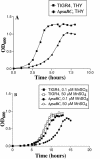Lipoprotein PsaA in virulence of Streptococcus pneumoniae: surface accessibility and role in protection from superoxide
- PMID: 15385487
- PMCID: PMC517531
- DOI: 10.1128/IAI.72.10.5858-5867.2004
Lipoprotein PsaA in virulence of Streptococcus pneumoniae: surface accessibility and role in protection from superoxide
Abstract
PsaA of Streptococcus pneumoniae, originally believed to be an adhesin, is the lipoprotein component of an Mn2+ transporter. Mutations in psaA cause deficiencies in growth, virulence, adherence, and the oxidative stress response. Immunofluorescence microscopy shows that PsaA is hidden beneath the cell wall and the polysaccharide capsule and only exposed to antibodies upon cell wall removal. A psaBC deletion mutant, expressing PsaA normally, was as deficient in adherence to Detroit 562 cells as were strains lacking PsaA. Thus, PsaA does not appear to act directly as an adhesin, but rather, psaA mutations indirectly affect this process through the disruption of Mn2+ transport. The deficiency in Mn2+ transport also causes hypersensitivity to oxidative stress from H2O2 and superoxide. In a chemically defined medium, growth of the wild-type strain was possible in the absence of Fe2+ and Mn2+ cations after a lag of about 15 h. Addition of Mn2+ alone or together with Fe2+ allowed prompt and rapid growth. In the absence of Mn2+, the addition of Fe2+ alone extended the 15-h lag phase to 25 h. Thus, while Fe2+ adversely affects the transition from lag phase to log phase, perhaps through increasing oxidative stress, this effect is relieved by the presence of Mn2+. A scavenger specific for superoxides but not those specific for hydroxyl radicals or H2O2 was able to eliminate the inhibition of growth caused by iron supplementation in the absence of Mn2+. This implies that superoxides are a key player in oxidative stress generated in the presence of iron.
Figures









Similar articles
-
A two-component system that controls the expression of pneumococcal surface antigen A (PsaA) and regulates virulence and resistance to oxidative stress in Streptococcus pneumoniae.Mol Microbiol. 2004 Mar;51(6):1661-75. doi: 10.1111/j.1365-2958.2003.03917.x. Mol Microbiol. 2004. PMID: 15009893
-
Virulence of Streptococcus pneumoniae: PsaA mutants are hypersensitive to oxidative stress.Infect Immun. 2002 Mar;70(3):1635-9. doi: 10.1128/IAI.70.3.1635-1639.2002. Infect Immun. 2002. PMID: 11854257 Free PMC article.
-
Competence and virulence of Streptococcus pneumoniae: Adc and PsaA mutants exhibit a requirement for Zn and Mn resulting from inactivation of putative ABC metal permeases.Mol Microbiol. 1997 Aug;25(4):727-39. doi: 10.1046/j.1365-2958.1997.5111879.x. Mol Microbiol. 1997. PMID: 9379902
-
Pneumococcal surface adhesin A (PsaA): a review.Crit Rev Microbiol. 2008;34(3-4):131-42. doi: 10.1080/10408410802275352. Crit Rev Microbiol. 2008. PMID: 18728990 Review.
-
Pneumococcal lipoproteins involved in bacterial fitness, virulence, and immune evasion.FEBS Lett. 2016 Nov;590(21):3820-3839. doi: 10.1002/1873-3468.12352. Epub 2016 Aug 24. FEBS Lett. 2016. PMID: 27508940 Review.
Cited by
-
Pneumococcal 6-phosphogluconate-dehydrogenase, a putative adhesin, induces protective immune response in mice.Clin Exp Immunol. 2006 May;144(2):254-63. doi: 10.1111/j.1365-2249.2006.03047.x. Clin Exp Immunol. 2006. PMID: 16634799 Free PMC article.
-
Molecular architecture of Streptococcus pneumoniae surface thioredoxin-fold lipoproteins crucial for extracellular oxidative stress resistance and maintenance of virulence.EMBO Mol Med. 2013 Dec;5(12):1852-70. doi: 10.1002/emmm.201202435. Epub 2013 Oct 18. EMBO Mol Med. 2013. PMID: 24136784 Free PMC article.
-
Emergence of hypervirulent mutants resistant to early clearance during systemic serotype 1 pneumococcal infection in mice and humans.J Infect Dis. 2014 Jul 1;210(1):4-13. doi: 10.1093/infdis/jiu038. Epub 2014 Jan 16. J Infect Dis. 2014. PMID: 24443543 Free PMC article.
-
Opposite effects of Mn2+ and Zn2+ on PsaR-mediated expression of the virulence genes pcpA, prtA, and psaBCA of Streptococcus pneumoniae.J Bacteriol. 2008 Aug;190(15):5382-93. doi: 10.1128/JB.00307-08. Epub 2008 May 30. J Bacteriol. 2008. PMID: 18515418 Free PMC article.
-
Intranasal immunization with the cholera toxin B subunit-pneumococcal surface antigen A fusion protein induces protection against colonization with Streptococcus pneumoniae and has negligible impact on the nasopharyngeal and oral microbiota of mice.Infect Immun. 2006 Aug;74(8):4939-44. doi: 10.1128/IAI.00134-06. Infect Immun. 2006. PMID: 16861686 Free PMC article.
References
-
- Andre, P., S. Bilger, P. Remy, S. Bettinger, and D. J. Vidon. 2003. Effects of iron and oxygen species scavengers on Listeria spp. chemiluminescence. Biochem. Biophys. Res. Commun. 304:807-811. - PubMed
-
- Archibald, F. S., and I. Fridovich. 1982. The scavenging of superoxide radical by manganous complexes: in vitro. Arch. Biochem. Biophys. 214:452-463. - PubMed
-
- Auzat, I., S. Chapuy-Regaud, G. Le Bras, D. Dos Santos, A. D. Ogunniyi, I. Le Thomas, J. R. Garel, J. C. Paton, and M. C. Trombe. 1999. The NADH oxidase of Streptococcus pneumoniae: its involvement in competence and virulence. Mol. Microbiol. 34:1018-1028. - PubMed
Publication types
MeSH terms
Substances
Grants and funding
LinkOut - more resources
Full Text Sources
Other Literature Sources

